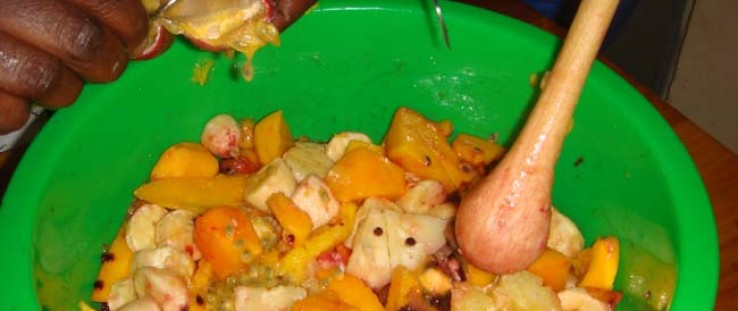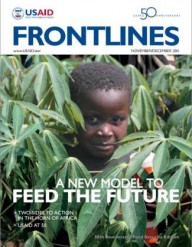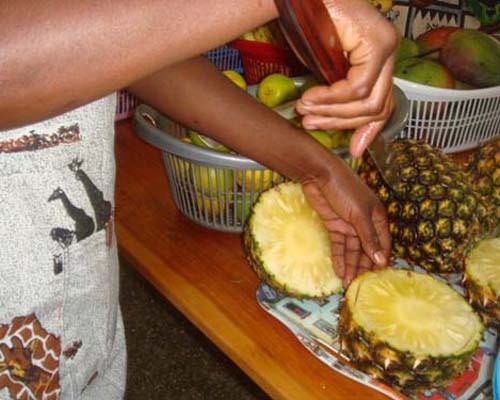 A fruit salad takes form during a nutrition education program at Rwanda’s Kibagabaga Hospital.
CHRISTINE SPETZ, INTRAHEALTH
A fruit salad takes form during a nutrition education program at Rwanda’s Kibagabaga Hospital.
CHRISTINE SPETZ, INTRAHEALTH
 A fruit salad takes form during a nutrition education program at Rwanda’s Kibagabaga Hospital.
CHRISTINE SPETZ, INTRAHEALTH
A fruit salad takes form during a nutrition education program at Rwanda’s Kibagabaga Hospital.
CHRISTINE SPETZ, INTRAHEALTH
Every day, Josephine Mukamana* straps her 18-month-old daughter to her back and walks the short distance from her home to the market. During the walk, she composes a grocery list in her head. There was a time when Mukamana’s list would not have included locally grown fruits such as bananas, oranges, pineapple, and passion fruit, but that was before she participated in a nutrition education program at Kibagabaga Hospital in Rwanda’s Gasabo district.
The 11-month program—the first of its kind at Kibagabaga Hospital—launched in August in response to survey findings that showed many children in the district are underweight and malnourished. Malnutrition in children can cause irreversible, long-term damage such as stunted growth and impaired cognitive development. Children can also suffer from anemia, goiter, and night-blindness when they are deficient in specific micronutrients, namely iron, iodine, and vitamin A, respectively.
In Rwanda, 44 percent of children under age 5 suffer from chronic malnutrition according to 2010 Demographic and Health Survey preliminary results.
“After hospital staff conducted a small survey of malnutrition in the Gasabo area, we discovered that the problem is not so much a lack of food, but rather the choices being made about what to eat. The biggest problem is knowledge. Understanding which foods keep the body healthy and help it grow,” says Dr. Christian Ntizimira, acting director at Kibagabaga Hospital.
“Chronic malnutrition is associated with a number of long-term factors including chronic insufficient protein and energy intake, frequent infection, sustained inappropriate feeding practices, and poverty. Some causes of malnutrition among children under 5 are insufficient food intake, infectious diseases, household food insecurity, and inappropriate care for children and women,” says Josephine Kayumba, nutrition specialist at USAID/Rwanda.
The nutrition education program that Mukamana participated in receives funding from the USAID-financed HIV/AIDS Clinical Services Program, which is run by IntraHealth International. The effort aims to combat malnutrition by teaching the Gasabo community about the importance of nutrient-rich foods and how to prepare these foods in the most nutritious way. In addition, mothers enrolled in the prevention of mother-to-child transmission services and their children are the primary target group for participation in order to minimize the side effects from antiretroviral drugs and to strengthen the immune system.
Hand Washing and Food Groups
At the program launch, Mukamana, along with 50 mothers accompanied by their children under 5, received a lesson on nutrition and fruit—the theme of that day’s program. During the program, the women learned about the relationship between nutrition and child development starting at birth; the importance of hand washing and other good hygiene practices when preparing food; and the need to include appropriate amounts of carbohydrates, proteins, vitamins, minerals, and fats in their daily diets.
From Hunger to Famine
Hunger: The sensation that comes from a lack of food in a person’s stomach.
Chronic Hunger: Hunger becomes chronic when a person doesn’t eat enough to get the energy he or she needs to lead an active life.
Undernutrition/Malnutrition: The outcome of insufficient food intake and repeated infectious diseases. It includes being underweight for one’s age, too short for one’s age (stunted), dangerously thin for one’s height (wasted), and deficient in vitamins and minerals (micronutrient malnutrition). UNICEF says one-third of all child deaths in the world can be attributed to undernutrition. Ironically, malnutrition can also refer to overnutrition, or “globesity.”
Underweight: This is measured by comparing the weight of a child against children of his or her same age who are considered well nourished and healthy.
Wasting: This term indicates acute malnutrition, reflecting a recent and severe situation—usually starvation or disease—that has led to substantial weight loss.
Famine: The United Nations declares a famine when at least 20 percent of a population consumes fewer than 2,100 calories of food a day; when malnutrition rates exceed 30 percent for children; and when more than two people per 10,000 people die each day (or when there are four child deaths per 10,000 people each day).
SOURCES: UNITED NATIONS, WORLD FOOD PROGRAM, UNICEF, U.S. CENTERS FOR DISEASE CONTROL AND PREVENTION
“I learned that I’m not always preparing nutrient-rich foods like vegetables and fish,” Mukamana says, adding that she now regularly includes small fish, particularly the dry ones called “Indagara,” from the market in the meals she prepares, in addition to carrots, cauliflower, spinach, peppers, and onions.
As part of the program, Mukamana also participated in a demonstration of how to prepare a fruit salad using locally available produce.
Although Mukamana says she and her husband cannot afford to purchase all the fruits needed to make a salad every day, they buy enough produce to make sure everyone at home eats a banana, an orange, or a piece of pineapple after every meal. The family is also consuming more vegetables and protein on a daily basis—small changes that are starting to make a difference.
“My daughter is happier now [that she’s eating healthier]. She has more energy, and her skin is improving,” Mukamana says. Vitamin-deficient skin is prone to developing rashes or becoming dry and thick.
“When others learn more about nutrition it will change the way they live and eat. People will realize that their children can be healthy too,” she adds.
“In general, Rwanda produces enough food to overcome malnutrition problems in the country. However, due to the limited food in the standard diet, children’s nutrient requirements are not being met,” says Kayumba. “More education is needed across the country on how to diversify the contents of meals, including the appropriate quantity, quality, and frequency to feed a child, as well as proper food preparation and feeding practices.”
In September, the nutritionist at Kibagabaga Hospital took the program to another health center in Gasabo district to give a second educational session. As part of this session, a group of mothers learned to make a vitamin-rich stew. The program was scheduled to offer a third classroom session this fall for district community health workers with the aim of encouraging them to talk more about nutrition with their clients.
The program aims to reach a different group every month and educate 250 to 300 families in the area.
In the future, hospital staff also want to reach schools, local leaders, and public institutions with essential nutritional information to prevent malnutrition and the kinds of non-communicable diseases like diabetes that it can lead to.
Christine Spetz is with IntraHealth
*Name has been changed for privacy reasons.










Comment
Make a general inquiry or suggest an improvement.